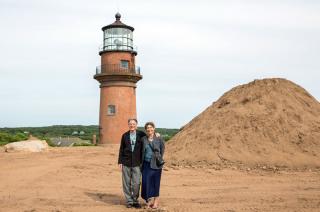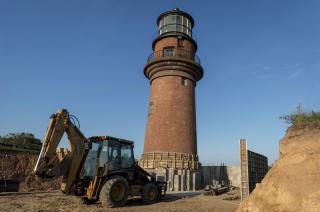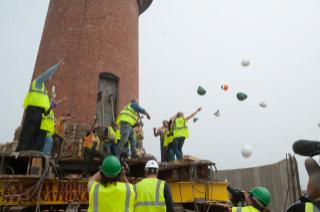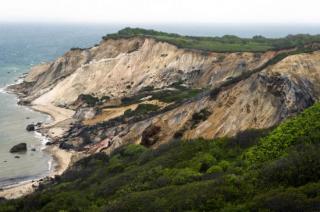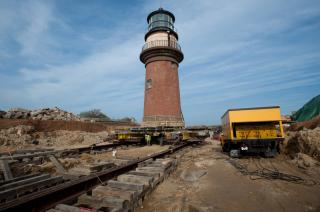Mariners, the U.S. Coast Guard and the National Oceanic and Atmospheric Administration are updating their charts to account for the light’s relocation away from the eroding cliffs.
More Coverage of Lighthouse Move
For almost 160 years, the Gay Head Light has stood at the westernmost part of Martha's Vineyard, a familiar and often beloved icon. But the clay cliffs underneath the lighthouse have proven less enduring, with erosion slowly bringing the lighthouse closer to the edge. This spring, after more than two years of planning and preparation, the 400-ton, 51-foot-tall lighthouse will be moved about 129 feet to a new location.

Under a steady downpour on Tuesday, the Gay Head Light resumed its watch over Vineyard Sound and the waters off Aquinnah. A large crowd gathered in Aquinnah Circle, peering up from under their umbrellas and hoods to witness the end of the lighthouse’s longest period of darkness since 1856.
Richard Skidmore and Joan LeLacheur, keepers of the Gay Head Light, have lived by the particular rhythms of the Gay Head Light for 25 years, tending to its mishaps and arranging countless visits with people from around the world.
With the summer season picking up, managers for the Gay Head Light relocation project hope to have the site mostly restored by the Fourth of July. About half the excavated soil has been returned to the site and a new concrete-block foundation is nearly complete.
The Gay Head Light relocation project continues, with a foundation of concrete blocks slowly rising around a gridwork of steel beams that supports the 400-ton structure. On May 30, the lighthouse was moved inland from the eroding cliffs.
With the smash of a champagne bottle and loud cheers, the Gay Head Light came to rest Saturday directly above the spot where experts believe it will be safe from erosion for 150 years or more.
Excavation around the Gay Head Light has revealed never before seen geologic layers that may shed light on how and when the landscape was created.
Working at an accelerated pace, crews moving the Gay Head Light expect to finish the job by Saturday morning. The lighthouse move began Thursday morning with much fanfare; the 1856 brick tower will travel 129 feetl east of the eroding cliff edge.
Just before noon on Thursday the Gay Head Light departed the spot where it has stood for 159 years. The Island's oldest lighthouse headed for its new home about 175 feet from the eroding Gay Head cliffs.



